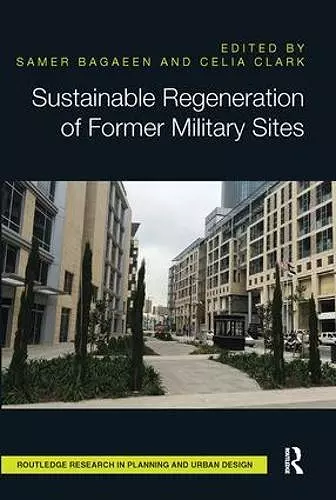Sustainable Regeneration of Former Military Sites
Samer Bagaeen editor Celia Clark editor
Format:Paperback
Publisher:Taylor & Francis Ltd
Published:28th Jun '18
Currently unavailable, and unfortunately no date known when it will be back
This paperback is available in another edition too:
- Hardback£155.00(9781138016521)

Sustainable Regeneration of Former Military Sites is the first book to analyze a profound land use change happening all over the world: the search for sustainable futures for property formerly dedicated to national defense now becoming redundant, disposed of and redeveloped. The new military necessity for rapid flexible response requires quite different physical resources from the massive fixed positions of the Cold War, with huge tracts of land and buildings looking for new uses.
The transition from military to civilian life for these complex, contaminated, isolated, heritage laden and often contested sites in locations ranging from urban to remote is far from easy. There is very little systematic analysis of what follows base closures, leaving communities, governments, developers, and planners experimenting with untested land use configurations, partnership structures, and financing strategies.
With twelve case studies drawn from different countries, many written by those involved, Sustainable Regeneration of Former Military Sites enables the diverse stakeholders in these projects to discover unique opportunities for reuse and learn from others’ experiences of successful regeneration.
"From a SAVE point of view the focus on the UK was of great interest...it is an engaging read...and subject matter is of great significance."
Mike, Fox, SAVE Britains Heritage, 2017
The book makes clear to the reader why this publication is so important in the field of urban studies at international level. By putting together several study cases from all over the world, it is claimed that former military and defense sites are inserted in the identification of those strategic areas of intervention regarding the significant potential and criticality of urban and rural areas, that is the relationship between mobility and air pollution, the role of the historical centre, areas dedicated to education, including complex issues such as scenarios related to economic development, work policies, housing, social and cultural needs.
Reviewed in the Journal of Urban Regeneration and Renewal by Camerin Federico, City planner and Fellow Researcher in Urban Planning, Department of Design and Planning in Complex Environments, IUAV University of Venice
Bagaeen and Clark present a unique collection of state-of-the-art case studies on the regeneration and re-use of military brownfields. This book explores practices from around the world to provide rich and new insights into how to transform sites once used for military purposes into new, and often innovative civilian uses. It usefully provides insights in to how to do this, set within wider understandings of the processes that bring about the redundancy of defence lands.
Gordon Dabinett, University of Sheffield
This book offers fascinating insights into the challenges and opportunities involved in transforming redundant military sites into beneficial new uses. Rich comparative evidence from across the world ensures that the book will make an important contribution to the brownfield literature.
David Adams, Ian Mactaggart Chair of Property and Urban Studies, University of Glasgow
Opportunities to reuse former defense estate, arising from a local peace dividend or a geopolitical shift, are often eagerly grasped by the public and private sectors. Former airfields, old barrack sites, and even large naval bases have been brought back to life through local or national regeneration efforts. In that way, demand for housing or new employment may be met through successful redevelopment. This new volume by Bagaeen and Clark brings together a collection of reviews and case studies examining the sustainable regeneration of military brownfields, written by researchers and by practitioners. It shines a light on the contexts in which reuse happens and the challenges it faces, drawing out crucial lessons for future practice.
Nick Gallent, Head of the Bartlett School of Planning, University College London
As the geopolitical world and military strategies of nations change, so the physical remnants of defense are left behind. Military and defense sites are littered across countries, lying idle but serving as assets that can be drawn upon to contribute to ongoing development and infrastructure needs. This volume provides a very welcome contribution to the study and practise of military and defense base regeneration across the globe. Written by internationally renowned scholars, the book sets out some key challenges and opportunities that academics and practitioners can learn from.
Mark Tewdwr-Jones, Newcastle University
…the book is well structured and it is recommended to a wide range of readers and professional people involved in the process of bringing military sites back into civilian use.
Camerin Federico,City planner and Fellow Researcher in Urban Planning, Department of Design and Planning in Complex Environments, IUAV University of Venice
ISBN: 9781138595057
Dimensions: unknown
Weight: 840g
226 pages